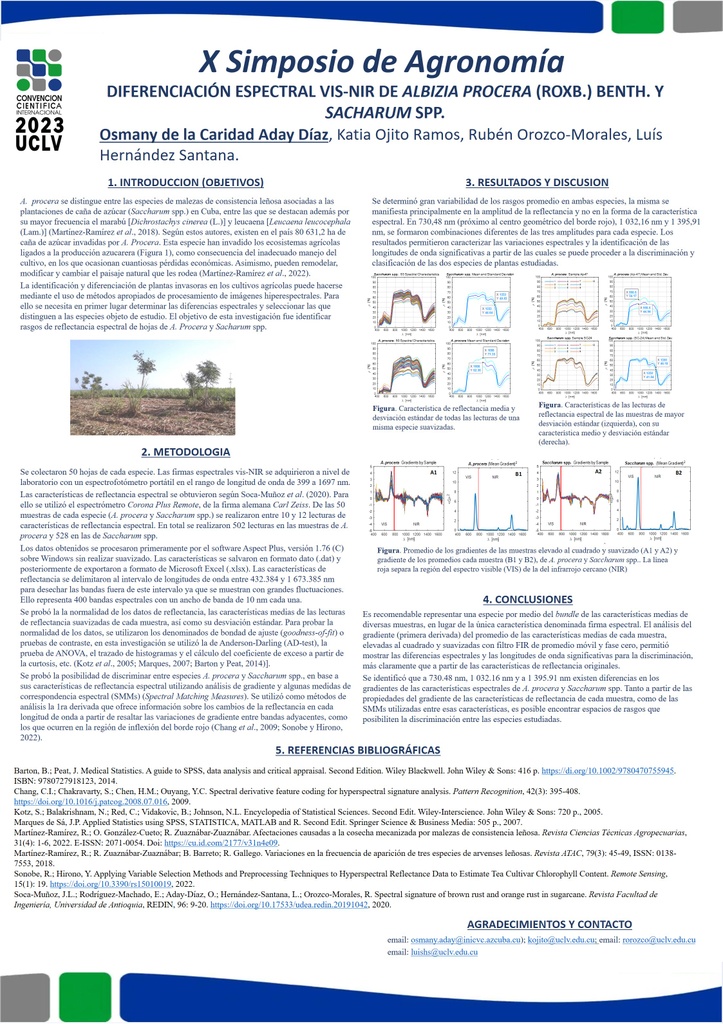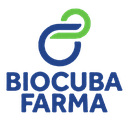Executive Secretary

9th International Scientific Conference on Agricultural Development and Sustainability
10th Symposium of Agronomy

Abstract
Problem: The identification and differentiation of invasive plants in agricultural crops can be done by using appropriate image processing methods. In the first place, it is necessary to determine the spectral differences and select those that distinguish the species under study. Albizia procera (Roxb.) Benth., is an invasive species in natural landscapes and agricultural ecosystems such as sugarcane (Sacharum spp.).
Objective(s): Identify spectral reflectance traits of leaves of A. Procera and Sacharum spp. 50 leaves of each species were collected.
Methodology: 50 leaves of each species were collected. The vis-NIR spectral signatures were acquired at the laboratory level with a portable spectrophotometer in the wavelength range of 399 to 1697 nm.
Results and discussion: Great variability of the average features was determined in both species, it is manifested mainly in the amplitude of the reflectance and not in the shape of the spectral characteristic. At 730.48 nm (close to the geometric center of the red border), 1032.16 nm, and 1395.91 nm, different combinations of the three amplitudes were formed for each species. The results allowed to characterize the spectral variations and the identification of the significant wavelengths from which it is possible to proceed to the discrimination and classification of the two studied plant species.
Conclusions: Proper band selection and local calibration using a spectral classification approach can facilitate the mapping of A. procera in a given geographic area.
Resumen
Problemática: La identificación y diferenciación de plantas invasoras en los cultivos agrícolas puede hacerse mediante el uso de métodos apropiados de procesamiento de imágenes. Se necesita en primer lugar determinar las diferencias espectrales y seleccionar las que distinguen a las especies objeto de estudio. Albizia procera (Roxb.) Benth., es una especie invasora en paisajes naturales y ecosistemas agrícolas como es el cultivo de caña de azúcar (Sacharum spp.).
Objetivo(s): Identificar rasgos de reflectancia espectral de hojas de A. Procera y Sacharum spp. Se colectaron 50 hojas de cada especie.
Metodología: Se colectaron 50 hojas de cada especie. Las firmas espectrales vis-NIR se adquirieron a nivel de laboratorio con un espectrofotómetro portátil en el rango de longitud de onda de 399 a 1697 nm.
Resultados y discusión: Se determinó gran variabilidad de los rasgos promedio en ambas especies, la misma se manifiesta principalmente en la amplitud de la reflectancia y no en la forma de la característica espectral. En 730,48 nm (próximo al centro geométrico del borde rojo), 1 032,16 nm y 1 395,91 nm, se formaron combinaciones diferentes de las tres amplitudes para cada especie. Los resultados permitieron caracterizar las variaciones espectrales y la identificación de las longitudes de onda significativas a partir de las cuales se puede proceder a la discriminación y clasificación de las dos especies de plantas estudiadas.
Conclusiones: la adecuada selección de bandas y la calibración local utilizando un enfoque de clasificación espectral, puede facilitar el mapeo de A. procera en un área geográfica determinada.
About The Speaker

Osmany de la Caridad Aday Díaz

Discussion

